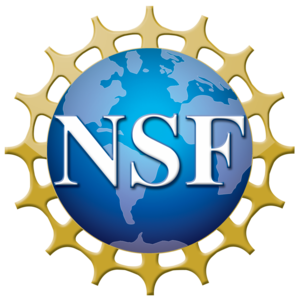Student Poster Abstracts
 Utkarsh Agrawal uagrawal@umass.edu University of Massachusetts, Amherst  |
Universality and Quantum Criticality in Quasiperiodic Spin ChainsQuasiperiodic systems are aperiodic but deterministic, so their critical behaviour differs from that of clean systems as well as disordered ones. Quasiperiodic criticality was previously understood only in the special limit where the couplings follow discrete quasiperiodic sequences. Here we consider generic quasiperiodic modulations; we find, remarkably, that for a wide class of spin chains, generic quasiperiodic modulations flow to discrete sequences under a real-space renormalization group transformation. These discrete sequences are therefore fixed points of a \emph{functional} renormalization group. This observation allows for an asymptotically exact treatment of the critical points. We use this approach to analyze the quasiperiodic Heisenberg, Ising, and Potts spin chains, as well as a phenomenological model for the quasiperiodic many-body localization transition. |
 Shah Saad Alam sa59@rice.edu Rice University 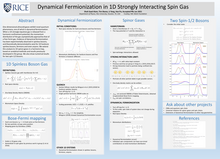 |
Dynamical Fermionization in One-Dimensional Spinor GasesOne dimensional ultracold gases exhibit novel quantum phenomena, one of which is dynamical fermionization. When a 1D strongly repulsive gas is released from a harmonic confinement potential, the momentum distribution of the gas asymptotically approaches that of a free Fermi gas. Evidence of dynamical fermionization has been experimentally observed in spinless bosons, and theoretically demonstrated to exist for 1D hardcore spinless bosons, fermions and even anyons. We extend this analysis to 1D spinor gases in a harmonic trap, based on analytical methods and results previously developed in the group. We also show numerical results for two spin-1/2 bosons.*
|
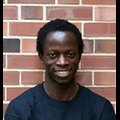 Jackson Ang'ong'a angonga2@illinois.edu University of Illinois, Urbana-Champaign 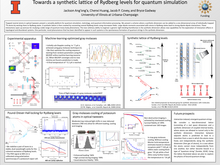 |
Towards a synthetic lattice of Rydberg levels for quantum simulationRydberg atoms in optical tweezer arrays present a versatile platform for quantum simulation, metrology and quantum information processing. We present a scheme that extends the capabilities of this platform by adding a synthetic dimension where several Rydberg levels are coupled by microwave fields to create a lattice. The near arbitrary ability to engineer a generic tight-binding Hamiltonian in the synthetic dimension, in addition to strong dipole-dipole interactions present in Rydberg atomic gases, allows new capabilities for the exploration of interaction effects in topological and disordered systems. |
 Ron Belyansky ron.belyansky@gmail.com University of Maryland 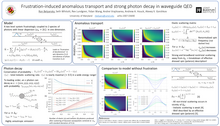 |
Frustration-induced anomalous transport and strong photon decay in waveguide QEDWe study the propagation of photons in a one-dimensional environment consisting of two non-interacting species of photons frustratingly coupled to a single spin-1/2. The ultrastrong frustrated coupling leads to an extreme mixing of the light and matter degrees of freedom, resulting in the disintegration of the spin and a breakdown of the “dressed-spin”, or polaron, description. Using a combination of numerical and analytical methods, we show that the elastic response becomes increasingly weak at the effective spin frequency, showing instead an increasingly strong and broadband response at higher energies. We also show that the photons can decay into multiple photons of smaller energies. The total probability of these inelastic processes can be as large as the total elastic scattering rate, or half of the total scattering rate, which is as large as it can be. The frustrated spin induces strong anisotropic photon-photon interactions that are dominated by inter-species interactions. Our results are relevant to state-of-the-art circuit and cavity quantum electrodynamics experiments. |
 Eliot Bohr eliot.bohr@nbi.ku.dk University of Copenhagen Niels Bohr Institute 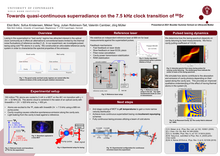 |
Towards quasi-continuous superradiance on the 7.5 kHz clock transition of 88-SrLasing in the superradiant or “bad cavity” regime has attracted interest in the optical clock community as it offers an alternative to conventional lasers limited by the thermal noise fluctuations of reference cavities. In our experiment, we investigate pulsed lasing using cold 88-Sr atoms in a cavity. We constructed an ultra-stable reference cavity system in order to characterize the spectral properties of the emission. We present results on dynamics of pulsed lasing at mK temperatures and discuss updates to the experiment which we are currently developing to increase the duration of these pulses.
|
 Kieran Bull pykb@leeds.ac.uk University of Leeds 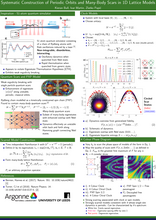 |
Systematic construction of scarred many-body dynamics in 1D lattice modelsWe introduce a family of non-integrable 1D lattice models that feature robust periodic revivals under a global quench from certain initial product states, thus generalizing the phenomenon of many-body scarring recently observed in Rydberg atom quantum simulators. Our construction is based on a systematic embedding of the single-site unitary dynamics into a kinetically-constrained many-body system. We numerically demonstrate that this construction yields new families of models with robust wave-function revivals, and it includes kinetically-constrained quantum clock models as a special case. We show that scarring dynamics in these models can be decomposed into a period of nearly free clock precession and an interacting bottleneck, shedding light on their anomalously slow thermalization when quenched from special initial states. |
 Eli Chertkov eli.chertkov@gmail.com University of Illinois, Urbana-Champaign 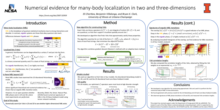 |
Numerical evidence for many-body localization in two and three-dimensionsDisordered quantum systems that exhibit many-body localization (MBL), the interacting generalization of Anderson localization, break the usual paradigm of quantum statistical mechanics and do not reach thermal equilibrium at long times. These systems exhibit a myriad of interesting properties, such as unusual entanglement and dynamics, and have been a subject of intense theoretical, numerical, and experimental study. Many properties of MBL are due to the existence of quasilocal integrals of motion known as localized bits, or “l-bits.” In this work, we present a new, general algorithm for constructing l-bits. While past numerical investigations of MBL have been primarily limited to one-dimensional chains, we show that our method can be used in arbitrary dimension. Our numerical results reveal some signatures of MBL in two and three-dimensional disordered Hamiltonians. |
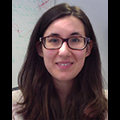 Elvia Colella elvia.colella@uibk.ac.at Innsbruck University 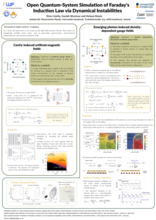 |
Open Quantum-System Simulation of Faraday's Induction Law via Dynamical InstabilitiesWe propose a novel type of cavity-QED set up to study the physics of dynamical gauge potentials. Atomic tunneling along opposite directions in the two legs of the ladder is mediated by photon scattering from transverse pump lasers to two distinct cavity modes. The steady-state atomic motion along the legs of the ladder leads either to a pure chiral current, screening the induced dynamical magnetic field as in the Meissner effect, or generates simultaneously chiral and particle currents. For sufficiently strongpump the system enters into a dynamically unstable regime exhibiting limit-cycle and period-doubled oscillations. An electromotive force is induced in this dynamical regime as expected from an interpretation based on Faraday’s law of induction for the time-dependent synthetic magnetic flux. |
 Ceren Dag cbdag@umich.edu University of Michigan 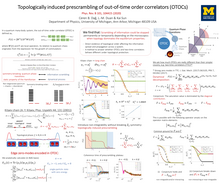 |
Topologically induced prescrambling and dynamical detection of topological phase transitions at infinite temperatureWe report a numerical observation where the infinite-temperature out-of-time-order correlators (OTOCs) directly probe quantum phase transitions at zero temperature, in contrast to common intuition where low energy quantum effects are washed away by strong thermal fluctuations at high temperature. By comparing numerical simulations with exact analytic results, we determine that this phenomenon has a topological origin and is highly generic, as long as the underlying system can be mapped to a 1D Majorana chain. Using the Majorana basis, we show that the infinite-temperature OTOCs probe zero-temperature quantum phases via detecting the presence of Majorana zero modes at the ends of the chain that is associated with 1D Z2 topological order. Hence, we show that strong zero modes also affect OTOCs and scrambling dynamics. Our results demonstrate an intriguing interplay between information scrambling and topological order, which leads to a new phenomenon in the scrambling of generic non-integrable models: topological order induced prescrambling, paralleling the notion of prethermalization of two-time correlators, that defines a time-scale for the restricted scrambling of topologically-protected quantum information. |
 Anna Dawid-Lekowska Anna.Dawid@fuw.edu.pl University of Warsaw 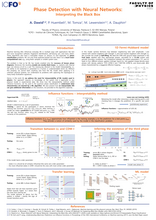 |
Phase Detection with Neural Networks: Interpreting the Black BoxNeural networks (NNs) usually hinder any insight into the reasoning behind their predictions. We demonstrate how influence functions can unravel the black box of NN when trained to predict the phases of the one-dimensional extended spinless Fermi-Hubbard model at half-filling. Results provide strong evidence that the NN correctly learns an order parameter describing the quantum transition in this model. We demonstrate that influence functions allow to check that the network, trained to recognize known quantum phases, can predict new unknown ones within the data set. Moreover, we show they can guide physicists in understanding patterns responsible for the phase transition. This method requires no a priori knowledge on the order parameter, has no dependence on the NN’s architecture or the underlying physical model, and is therefore applicable to a broad class of physical models or experimental data. [1] A. Dawid et al. 2020. New J. Phys. 22 115001
|
 Giulia De Rosi giulia.derosi88@gmail.com UPC – Universitat Politècnica de Catalunya 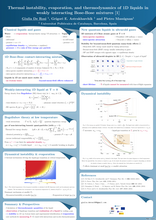 |
Thermal instability, evaporation, and thermodynamics of 1D liquids in weakly interacting Bose-Bose mixturesGiulia De Rosi, Grigori E. Astrakharchik, and Pietro Massignan We study the low-temperature thermodynamics of weakly interacting uniform liquids in one-dimensional attractive Bose-Bose mixtures. The Bogoliubov approach is used to simultaneously describe quantum and thermal fluctuations. First, we investigate in detail two different thermal mechanisms driving the liquid-to-gas transition, the dynamical instability, and the evaporation, and we draw the phase diagram. Then, we compute the main thermodynamic quantities of the liquid, such as the chemical potential, the Tan’s contact, the adiabatic sound velocity, and the specific heat at constant volume. The strong dependence of the thermodynamic quantities on the temperature may be used as a precise temperature probe for experiments on quantum liquids. G. De Rosi, G. E. Astrakharchik, and P. Massignan, Phys. Rev. A 103, 043316 (2021)
|
 Tharindu W. Fernando tharindu@uw.edu University of Washington 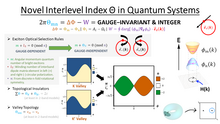 |
Novel Interband Topological Invariant in Condensed MatterThe physical significance of a recently-proposed gauge-invariant interband index is not immediately clear in condensed matter systems. In this poster presentation, I summarize some results from 3+ years of my work on the index. These include potentially new applications in topological insulators, exciton selection rules, and the topological characterizations of ‘valleys’. |
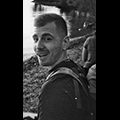 Fabian Finger ffinger@phys.ethz.ch Institute for Quantum Electronics, ETH Zurich 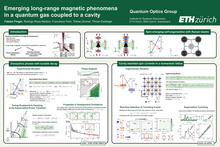 |
Emerging long-range magnetic phenomena in a quantum gas coupled to a cavityDissipative and coherent processes are at the core of the evolution of many-body systems. Their competition and interplay can lead to new phases of matter, instabilities, and complex non-equilibrium dynamics. However, probing these phenomena at a microscopic level in a setting of well-defined, controllable coherent and dissipative couplings often proves challenging. In our setup, we realize such a quantum many-body system using a 87Rb spinor Bose-Einstein condensate (BEC) strongly coupled to a single optical mode of a lossy cavity. Two transverse laser fields incident on the BEC allow for cavity-assisted Raman transitions between different motional states of two neighboring spin levels. In a first set of experiments, adjusting the imbalance between the drives enables us to tune the competition between coherent dynamics and dissipation, with the appearance of a dissipation-stabilized phase and bistability. We relate the observed phases to microscopic elementary processes in the open system by characterizing the properties of the underlying polariton modes. Moreover, we report on recent results showing collective spin dynamics in a cavity via superradiant Raman scattering. We identify the collective nature of the transitions and leverage the leaking photon field to gain real-time, non-destructive readout of the system’s dynamics. Together, our results open new avenues for investigating non-Hermitian systems, spin-orbit coupling in dissipative settings, and transport phenomena in light-matter systems. |
 Sayed Ali Akbar Ghorashi sghorashi@wm.edu William & Mary  |
Higher-Order Weyl SemimetalsWe investigate higher-order Weyl semimetals (HOWSMs) having bulk Weyl nodes attached to both surface and hinge Fermi arcs. We identify a new type of Weyl node, which we dub a 2nd-order Weyl node, that can be identified as a transition in momentum space in which both the Chern number and a higher order topological invariant change. As a proof of concept we use a model of stacked higher order quadrupole insulators (QI) to identify three types of WSM phases: 1st order, 2nd order, and hybrid order. The model can also realize type-II and hybrid-tilt WSMs with various surface and hinge arcs. After a comprehensive analysis of the topological properties of various HOWSMs, we turn to their physical implications that show the very distinct behavior of 2nd-order Weyl nodes when they are gapped out. We obtain three remarkable results: (i) the coupling of a 2nd-order Weyl phase with a conventional 1st-order one can lead to a hybrid-order topological insulator having coexisting surface cones and flat hinge arcs that are independent and not attached to each other. (ii) A nested 2nd-order inversion-symmetric WSM by a charge-density wave (CDW) order generates an insulating phase having coexisting flatband surface and hinge states all over the Brillouin zone. (iii) A CDW order in a time-reversal symmetric higher-order WSM gaps out a 2nd-order node with a 1st-order node and generates an insulating phase having coexisting surface Dirac cone and hinge arcs. Moreover, we show that a measurement of charge density in the presence of magnetic flux can help to identify some classes of 2nd-order WSMs. Finally, we show that periodic driving can be utilized as a way for generating HOWSMs. Our results are relevant to metamaterials as well as various phases of Cd3As2, KMgBi, and rutile-structure PtO2 that have been predicted to realize higher order Dirac semimetals. |
 Tomohiro Hashizume tomohiro.hashizume@strath.ac.uk University of Strathclyde 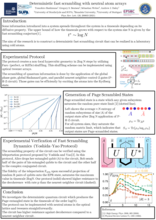 |
Deterministic fast scrambling with neutral atom arraysFast scramblers are the systems which can propagate the information across the system in a timescale which only scales logarithmically with the system size. We propose a deterministic fast-scrambling circuit, which can be implemented in the near-future experiments using neutral atoms. The protocol utilizes the highly non-local geometry created by the shuffling of atoms using optical tweezers. We show that Page-scrambled state, a pure state in which every random subsystem are maximally entangled, can be generated with our protocol in the number of operations which only increases logarithmically with the system size. We also show that the proposed circuit has high resistance against the depolarization noise. This makes the circuit an ideal circuit to be used for the quantum teleportation protocols. |
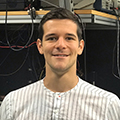 Michael Highman highman2@illinois.edu University of Illinois at Urbana-Champaign 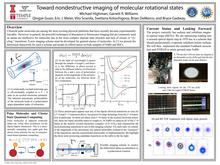 |
Quantum Cluster-states of Ultracold Polar MoleculesUltracold molecules have seen recent success as a tool in ultracold chemistry, probing fundamental physics, and quantum simulation. The plentiful array of internal states in molecules enables their use in a wide range of studies. As such, certain states of ultracold polar molecules demonstrate the ability to interact coherently over long times through coupling of their electric dipole moments, a quality of interest towards efforts in producing stable and noise-resistant qubits. This dipolar exchange interaction can entangle qubits through microwave coupling of anisotropic rotational states in 23Na87Rb and synthesize a cluster-state, opening the door for cluster-state computing. To resolve and process information after measurement, cluster-state computing relies on the ability to monitor constituent qubits of the state non-destructively and selectively. Presented here is a non-demolition imaging scheme that takes advantage of anisotropic rotational states of polar molecules. Additionally, described here are methods of fabrication and manipulation of 23Na87Rb qubits for future work towards cluster-state computing. With Garrett Williams |
 Raphael Holzinger raphael.holzinger@uibk.ac.at Institute for Theoretical Physics, Innsbruck, Austria 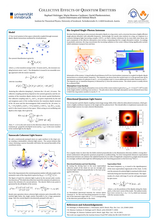 |
Collective Effects of Quantum EmittersRecent studies have shown that sub-wavelength sized rings of quantum emitters possess subradiant eigenmodes which mimic high-Q optical resonators. We add a continuously pumped atom as a gain medium in the ring’s center creating a minimalistic coherent light source. The system behaves like a thresholdless laser, featuring a narrow linewidth well below the natural linewidth of the constituent atoms. We also show that by placing an extra resonant absorptive dipole at the ring center, such a structure becomes a highly efficient single-photon absorber with tailorable frequency. Interestingly, for exactly nine emitters in a nonagon, as it appears in a common biological light-harvesting complex (LHC2), we find a distinct minimum for its most dark state decay rate and a maximum of the effective absorption cross-section, surpassing that for a single absorptive emitter. Furthermore we show the implementation of nanoscale non-classical light sources via weak coherent illumination. At the generic tailored examples of regular chains we show that the fields emitted perpendicular to the illumination direction exhibit a strong directional confinement with genuine quantum properties as antibunching. |
 Ana Hudomal a.hudomal@leeds.ac.uk University of Leeds  |
Quantum scars of bosons with correlated hoppingRecent experiments have shown that preparing an array of Rydberg atoms in a certain initial state can lead to anomalously slow thermalization and persistent density oscillations [1]. This type of non-ergodic behavior has been attributed to the existence of “quantum many-body scars”, i.e., atypical eigenstates that have high overlaps with a small subset of vectors in the Hilbert space. Periodic dynamics and many-body scars are believed to originate from a “hard” kinetic constraint: due to strong interactions, two neighboring Rydberg atoms cannot be simultaneously excited. Here we propose a realization of quantum many-body scars in a 1D bosonic lattice model with a “soft” constraint in the form of density-assisted hopping [2]. We find that this model exhibits similar phenomenology to the Rydberg atom chain, including weakly entangled eigenstates at high energy densities and the presence of a large number of exact zero energy states, with distinct algebraic structure. We discuss the relation of this model to the standard Bose-Hubbard model and possible experimental realizations using ultracold atoms.
References:
[1] H. Bernien et al., Nature 551, 579 (2017).
[2] A. Hudomal, I. Vasic, N. Regnault, and Z. Papic, Commun. Phys. 3, 99 (2020).
|
 Eduardo Ibarra Garcia Padilla eibarragp@rice.edu Rice University 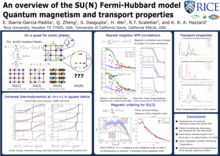 |
An overview of the SU(N) Fermi Hubbard model: Quantum magnetism and transport propertiesThe SU(2) symmetric Fermi Hubbard model (FHM) plays an essential role in the understanding of strongly correlated fermionic many-body systems. When the system is in the one particle per site and strongly interacting limit U >> t , it is effectively described by the Heisenberg Hamiltonian. In this limit, extending the typical SU(2) symmetry to SU(N) has been predicted to give exotic phases of matter in the ground state, with complicated dependence of the ground state on N. In this overview we discuss the N-dependence of thermodynamic properties, magnetic correlations and transport properties of the SU(N) Fermi Hubbard model at finite temperature and away from the Heisenberg limit. In particular we address the question of what signatures of the exotic ground states survive at finite-temperature, especially in the currently experimentally relevant regime near or above the superexchange energy. Our results are obtained with Exact Diagonalization, Numerical Linked Cluster Expansions and Determinant Quantum Monte Carlo and span a wide range of interaction strengths, temperatures, fillings and values of N. |
 Romaric Journet romaric.journet@institutoptique.fr Laboratoire Charles Fabry 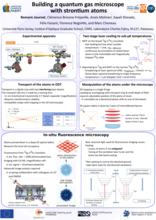 |
Shelving spectroscopy of strontium intercombination line in a vapor cellThe relaxation dynamics of quantum many-body systems after a quench is so far a mostly unsolved problem.We plan on using a quantum gas microscope to study the relaxation dynamics of a 2D strontium gas in an optical lattice. The quantum gas microscope approach will allow us to probe the spatial distribution of atoms with single atom and single lattice site resolution. In this poster, I present the experimental apparatus that was designed for our experiment. I discuss the challenges that were addressed and how we chose to circumvent them. More precisely, I tackle the topics of collimation and cooling of a strontium gas from several hundreds of degrees to a few µK. I also present the design of the optical dipole traps for the lattices and a transport of a cold atomic cloud. Finally, a section of the poster summarizes the constraints on achieving detection of single atoms in a 2D lattice with an in situ imaging. |
 Thomas Kiely tgk37@cornell.edu Cornell University 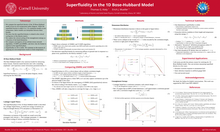 |
Superfluidity in the 1D Bose-Hubbard ModelWe study superfluidity in the 1D Bose-Hubbard model using an infinite variational matrix product state technique. We determine the superfluid density as a function of the Hubbard parameters by calculating the energy cost of phase twists in the thermodynamic limit. As the system is critical, correlation functions decay as power laws and the entanglement entropy grows with the bond dimension of our variational state. We relate the resulting scaling laws to the superfluid density. We compare two different algorithms for optimizing the infinite matrix product state and develop a physical explanation why one of them (VUMPS) is more efficient than the other (iDMRG). Finally, we comment on finite-temperature superfluidity in one dimension and how our results can be realized in cold atom experiments. |
 Francisco Machado fmachado@berkeley.edu University of California, Berkeley 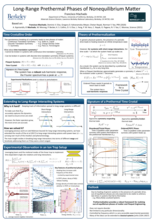 |
Long-Range Prethermal Phases of Nonequilibrium MatterRecent developments in atomic, molecular and optical systems have enabled unprecedented access to novel out-of-equilibrium behavior—even in strongly interacting many-body systems. Such techniques have led to an explosion of excitement in this field, with particular attention being given to periodically driven system. In such systems the discrete time translation symmetry of the evolution can lead to entirely new phases of matter, but also to one major hurdle: the heating problem. More specifically, a generic strongly interacting driven system will continuously absorb energy from the drive until it approaches the infinite temperature state at late times, destroying any interesting out-of-equilibrium behavior. Here, I will discuss how Floquet prethermalization enables us to overcome this problem and realize novel out-of-equilibrium phases. By focusing on high-frequency driven systems, the heating absorption rate from the drive becomes exponentially small, enabling a parametrically large time scale for observing out-of-equilibrium phenomena. I will discuss our work extending this approach to long-range interacting systems and how an emergent symmetry can arise (protected by the time translation symmetry of the drive). Leveraging this emergent symmetry, I will present an example how a novel time crystalline phase can be stabilized — the one dimensional prethermal time crystal— and discuss a recent experimental observation of this phenomena.
|
 Manuel Munoz-Arias mhmunoz@unm.edu University of New Mexico 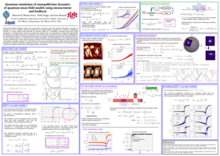 |
Quantum simulation of nonequlibrium dynamics of quantum mean-field models using measurement and feedbackMeasurement-based feedback control has a long history in quantum optics and quantum information. However, its potential as a tool to engineer quantum simulations has remained largely unexplored. We consider nonequilibrium dynamics of p-spin models which describe an Ising-like model on a completely connected graph with p-body interactions. To simulate these models, we consider the collective spin of an ensemble on N qubits and approximate the dynamics by weakly measuring one projection of the collective spin, followed by unitary evolution conditioned on the measurement outcome. Using the proposed protocol we explore dynamical quantum phase transitions (DQPT-I) for some relevant values of p. Furthermore, we explore emergence of chaotic dynamics in the delta-kicked p-spin models, characterizing it via the largest Lyapunov exponent of the simulated quantum trajectories. Finally, we consider our feedback simulation protocol in a 1D model of a free space atom-light interface, which includes the effects of decoherence induced by diffusive scattering of photons. We provide numerical evidence that the simulated DQPT-I could be accessible in state of the art atom-light interface experiments. |
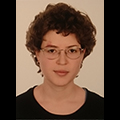 Eulàlia Nicolau eulalia.nicolau@uab.cat Universitat Autònoma de Barcelona 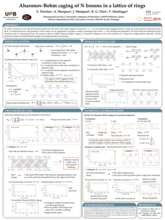 |
Aharonov-Bohm caging of N bosons in a lattice of ringsWe study a system of a few ultracold bosons loaded into the states with orbital angular momentum l=1 of a one-dimensional staggered lattice of rings. By analyzing the strong-interaction limit, we demonstrate how the geometry of the system can be engineered to produce complex tunnelings that yield a pi flux through the plaquettes. We find nontrivial topological band structures and we demonstrate how the system is able to exhibit Aharonov-Bohm caging in N-particle subspaces even in the presence of a dispersive single-particle spectrum. All the analytical results are benchmarked through exact diagonalization simulations. |
 Daniel Paz dap12d@gmail.com Michigan State University  |
Modified fluctuation-dissipation relation in driven-dissipative systemsFluctuation-dissipation relations (FDRs) and time-reversal symmetry (TRS), two pillars of statistical mechanics, are both broken in generic driven-dissipative systems. These systems rather lead to non-equilibrium steady states far from thermal equilibrium. Driven-dissipative Ising-type models, however, are widely believed to exhibit effective thermal critical behavior near their phase transitions. Contrary to this picture, we show that both the FDR and TRS are broken even macroscopically at, or near, criticality. This is shown by inspecting different observables, both even and odd operators under time-reversal transformation, that overlap with the order parameter. Remarkably, however, a modified form of the FDR as well as TRS still holds, but with drastic consequences for the correlation and response functions as well as the Onsager reciprocity relations. |
 Valerio Peri periv@phys.ethz.ch ETH Zurich 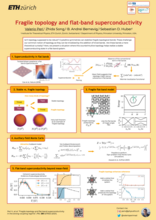 |
Fragile topology and flat-band superconductivityRecent theoretical works unveiled that crystalline symmetries can stabilize topologically fragile Bloch bands that challenge our very notion of topology: one can trivialize these bands through the addition of trivial Bloch bands. Here, we show via auxiliary-field Monte Carlo simulations how fragile topology enhances the superfluid weight and hence the superconducting critical temperature. This feature is particularly relevant in flat-band systems where the conventional contribution to the superfluid weight vanishes and might explain the high transition temperature observed in magic-angle twisted bilayer graphene. |
 Lukas Rammelmüller lukas.rammelmueller@physik.uni-muenchen.de LMU Munich 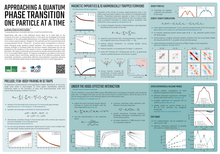 |
Approaching a Quantum Phase Transition one Atom at a TimeExperiments with only a few individual atoms allow us to shed light on the crossover from few- to many-body physics. In this spirit, we investigate a few-body counterpart of the well-studied phenomenon of a magnetic impurity in the vicinity of an s -wave superconductor. Already for few particles we find a ground-state level crossing between a non-magnetic and a magnetic sector, which corresponds to a fermion-parity changing sharp quantum phase transition. This transition occurs as the impurity strength is increased while the fermions interact attractively and can be explained by the tendency of the system to form a single-particle gap due to pair formation. We obtain numerically sound results by exactly solving the problem with FCI in a truncated Hilbert space. To improve convergence we exploit a trick known in the nuclear theory community, namely the use of an effective potential, which essentially constitutes a particularly effective renormalization procedure allowing us to more efficiently obtain physical observables free from a cutoff dependence. |
 Alexander Schuckert alexander.schuckert@tum.de Technical University of Munich  |
Superdiffusive emergent hydrodynamics in trapped ion quantum simulatorsGeneric short-range interacting quantum systems with a conserved quantity exhibit universal diffusive transport at late times. We employ non-equilibrium quantum field theory and semi-classical phase-space simulations to show how this universality is replaced by a more general transport process in a long-range XY spin chain at infinite temperature with couplings decaying algebraically with distance as r^ {−α}. While diffusion is recovered for α>1.5, longer-ranged couplings with 0.5<α≤1.5 give rise to effective classical Lévy flights; a random walk with step sizes drawn from a distribution with algebraic tails. We find that the space-time dependent spin density profiles are self-similar, with scaling functions given by the stable symmetric distributions. As a consequence, for 0.5<α≤1.5 autocorrelations show hydrodynamic tails decaying in time as t^{−1/(2α−1) }and linear-response theory breaks down. We also discuss the recent observation of these unconventional hydrodynamics in a trapped ion quantum simulator.
|
 Vaibhav Sharma vs492@cornell.edu Cornell University  |
Condensed bosons get squeezed and enter the lowest landau level in a rotating frameMotivated by a recent experiment, we model interacting bosons in a harmonic trap with a rotating elliptical deformation. The system Hamiltonian in the rotating frame is equivalent to the Hamiltonian for a charged particle in a uniform magnetic field. Bosons condensed in the lowest landau level can serve as a route to study fractional quantum hall physics and strong interaction effects in a flat band with neutral cold atoms. We show how bosons in this situation can dynamically enter the lowest landau level. We use a time-dependent variational wavefunction approach to efficiently model the dynamics. We find that our approach reliably captures a dynamical squeezing of the Bose gas observed in the experiment. We also find that the bosons macroscopically occupy the lowest landau level only if the elliptical deformation is switched off slowly over a particular timescale. We estimate this timescale and provide an intuitive understanding of the phenomena. |
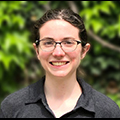 Grace Sommers gsommers@princeton.edu Princeton University 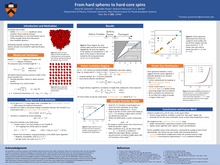 |
From hard spheres to hard-core spinsA system of hard spheres exhibits physics that is controlled only by their density. This comes about because the interaction energy is either infinite or zero, so all allowed configurations have exactly the same energy. The low-density phase is liquid, while the high-density phase is crystalline, an example of “order by disorder” as it is driven purely by entropic considerations. Here we study a family of hard spin models, which we call hard-core spin models, where we replace the translational degrees of freedom of hard spheres with the orientational degrees of freedom of lattice spins. Their hard-core interaction serves analogously to divide configurations of the many spin system into allowed and disallowed sectors. We present detailed results on the square lattice in $d=2$ for a set of models with $Z_N$ symmetry, which generalize Potts models, and their $U(1)$ limits, for ferromagnetic and antiferromagnetic senses of the interaction, which we refer to as exclusion and inclusion models. As the exclusion and inclusion angles are varied, we find a Kosterlitz-Thouless phase transition between a disordered phase and a phase with quasi-long-ranged order, which is the form order by disorder takes in these systems. These results follow from a set of height representations, an ergodic cluster algorithm, and transfer matrix calculations. Reference: Grace M. Sommers, Benedikt Placke, Roderich Moessner, and S. L. Sondhi, Phys. Rev. B 103, 104407 (2021). |
 Varsha Subramanyan varshas2@illinois.edu University of Illinois, Urbana-Champaign 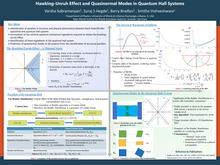 |
Quasinormal Modes and Hawking-Unruh Effect in Quantum Hall SystemsIn this work, we take a closer look at wavepacket scattering through a quantum point contact (QPC) in an integer quantum Hall system. We model the QPC as a hyperbolic potential which takes the form of an inverted harmonic oscillator (IHO) in the lowest Landau level. The symmetry isomorphisms that this system shares with 1D quantum phase space as well as as (2+1)D Rindler spacetime leads to parallels of relativistic phenomena in this non-relativistic scattering setup. We exploit this connection to study quantum Hall parallels to quasinormal modes, the Hawking-Unruh effect, quantum optics etc. |
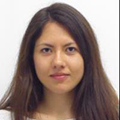 Federica Maria Surace federicamsurace@gmail.com SISSA 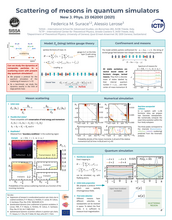 |
Scattering of mesons in quantum simulatorsSimulating real-time evolution in theories of fundamental interactions represents one of the central challenges in contemporary theoretical physics. Cold-atom platforms stand as promising candidates to realize quantum simulations of non-perturbative phenomena in gauge theories, such as vacuum decay and hadron collisions, in prohibitive conditions for direct experiments. In this work, we demonstrate that present-day quantum simulators can imitate linear particle accelerators, giving access to S-matrix measurements of elastic and inelastic meson collisions in low-dimensional abelian gauge theories. Considering for definiteness a (1 + 1)-dimensional Z2-lattice gauge theory realizable with Rydberg-atom arrays, we present protocols to observe and measure selected meson–meson scattering processes. We provide a benchmark theoretical study of scattering amplitudes in the regime of large fermion mass, including an exact solution valid for arbitrary coupling strength. This allows us to discuss the occurrence of inelastic scattering channels, featuring the production of new mesons with different internal structures. We present numerical simulations of realistic wavepacket collisions, which reproduce the predicted cross section peaks. This work highlights the potential of quantum simulations to give unprecedented access to real-time scattering dynamics. |
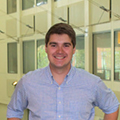 Joseph Szabo szabo.48@osu.edu Ohio State University  |
Detecting quantum phases by probing ancillary qubitsUnderstanding the role of entanglement and its dynamics in composite quantum systems lies at the forefront of quantum matter studies. Here we investigate competing entanglement dynamics in an open Ising-spin chain that allows for exchange with an external central qudit probe. We propose a new metric dubbed the multipartite entanglement loss (MEL) that provides an upper bound on information entropy shared between the spins and qudit probe, serving to unify physical spin-fluctuations, Quantum Fisher Information (QFI), and bipartite entanglement entropy. We find interestingly that collective spin-fluctuations which serve as a witness for multipartite spin-spin entanglement, can also be used to quantify the composite entanglement shared between spins and qudit environment. In addition to studying the entanglement dynamics of the qudit in a weak probe capacity, we also study how just a single, non-local ancillary qubit is able to distribute entanglement and operator content. Using entanglement entropy and out-of-time-order correlations, we find that in the weak coupling regime, the non-local nature of central qubit allows for rapid entanglement distribution and in the strong coupling limit, the star-local system develops sub-ballistic growth of entanglement and slow operator growth. |
 Jugal Talukdar jugal.talukdar@ou.edu University of Oklahoma, Norman 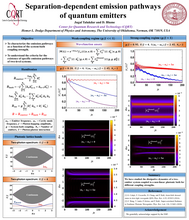 |
Separation-dependent emission pathways of quantum emittersSystem-environment interactions have been studied extensively for many decades and recent developments in quantum optics and circuit QED provide intriguing possibilities for realizing non-linear environments. The Bose-Hubbard lattice for photons, e.g., has been realized experimentally using superconducting circuits, thereby providing an exciting platform to study effective interactions between quantum emitters mediated by the engineered photonic environment. We consider a collection of macroscopically separated two-level emitters coupled to a non-linear environment and study the dissipative dynamics. Specifically, we report our theoretical progress on understanding the criteria for the existence of specific emission pathways as a function of the positions of the emitters. |
 Agnes Valenti avalenti@phys.ethz.ch ETH Zurich 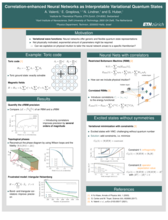 |
Correlation-Enhanced Neural Networks as Interpretable Variational Quantum StatesVariational methods have proven to be excellent tools to approximate ground states of complex many body Hamiltonians. Generic tools like neural networks are extremely powerful, but their parameters are not necessarily physically motivated. Thus, an efficient parametrization of the wave-function can become challenging. In this letter we introduce a neural-network based variational ansatz that retains the flexibility of these generic methods while allowing for a tunability with respect to the relevant correlations governing the physics of the system. We illustrate the success of this approach on topological, long-range correlated and frustrated models. Additionally, we introduce compatible variational optimization methods for exploration of low-lying excited states without symmetries that preserve the interpretability of the ansatz. |
 Botao Wang botao@pks.mpg.de Max Planck Institute for the Physics of Complex Systems 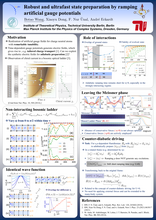 |
Engineering artificial gauge potentials for rapid adiabatic state preparationThe implementation of static artificial magnetic fields in ultracold atomic systems has been established as a powerful tool, e.g. for simulating quantum-Hall physics with charge-neutral atoms. Taking an interacting bosonic flux ladder as a minimal model, we investigate protocols for adiabatic state preparation based on ramping up the vector potential (in the form of Peierls phases), which is engineered to give rise to the desired magnetic flux. We find that the time required for adiabatic state preparation dramatically depends on the spatial pattern of Peierls phases used to create the flux. This is explained by the fact that, while different patterns (i.e. vector potentials) just correspond to different gauges for static fluxes, they induce different electric fields during the ramp. Remarkably, we find that for an optimal choice, it allows for preparing the ground state almost instantaneously. This can be related to counter-diabatic driving and may open up new possibilities for robust state preparation.
Authors: Botao Wang, Xiaoyu Dong, F. Nur ünal, and André Eckardt
|
 Dariusz Wiater dariusz.wiater@fuw.edu.pl University of Warsaw 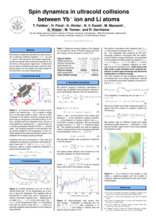 |
Spin dynamics in ultracold collisions between Yb+ ion and Li atoms in the quantum regimeSignificant advances in precision measurements in the quantum regime have been achieved with trapped ions and atomic gases at the lowest possible temperatures. These successes have inspired ideas to merge the two systems [1]. Remarkably, in spite of its importance, experiments with ion-atom mixtures remained firmly confined to the classical collision regime, but recently buffer gas cooling of a single ion in a Paul trap to the quantum regime of ion-atom collisions has been realized[2]. The collision energy as small as 1.15(0.23) times the s-wave energy (or 9.9(2.0) μK) has been achieved for a trapped ytterbium ion in an ultracold lithium gas. We have observed a deviation from classical Langevin theory by studying the spin-exchange dynamics, indicating quantum effects in the collisions. Here, we present a theoretical description of the quantum ion-atom scattering used to guide and interpret the recent experiment [2]. By developing a theoretical model of measured energy-dependent spin-exchange rate constants, we have obtained singlet and triplet ion-atom scattering lengths. Next, we identify experimentally accessible Feshbach resonances in the mentioned systems and predict their properties. Control of both elastic scattering and related cooling rates, as well as inelastic spin-changing collisions, with the magnetic field is proposed and investigated to guide ongoing experimental efforts. Ion-atom Feshbach resonances in analogy to well-established techniques for neutral systems will be an important tool to manipulated ultracold ion-atom mixtures. [1] Tomza et al, Rev. Mod. Phys. 91, 035001 (2019). |
 Garrett Williams grw5@illinois.edu University of Illinois, Urbana-Champaign 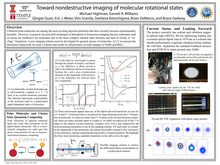 |
Quantum Cluster-states of Ultracold Polar MoleculesUltracold molecules have seen recent success as a tool in ultracold chemistry, probing fundamental physics, and quantum simulation. The plentiful array of internal states in molecules enables their use in a wide range of studies. As such, certain states of ultracold polar molecules demonstrate the ability to interact coherently over long times through coupling of their electric dipole moments, a quality of interest towards efforts in producing stable and noise-resistant qubits. This dipolar exchange interaction can entangle qubits through microwave coupling of anisotropic rotational states in 23Na87Rb and synthesize a cluster-state, opening the door for cluster-state computing. To resolve and process information after measurement, cluster-state computing relies on the ability to monitor constituent qubits of the state non-destructively and selectively. Presented here is a non-demolition imaging scheme that takes advantage of anisotropic rotational states of polar molecules. Additionally, described here are methods of fabrication and manipulation of 23Na87Rb qubits for future work towards cluster-state computing. With Michael Highman |
 Tianrui Xu tianrui_xu@berkeley.edu University of California, Berkeley 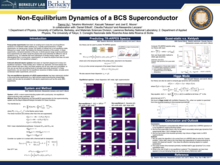 |
Non-Equilibrium Dynamics of a BCS SuperconductorRecently developed experimental tools that control and probe many-body quantum systems have provided access to new time and length scales of various quantum systems. Techniques such as pump-probe experiments and cavity quantum electrodynamics have enabled us to explore and understand the phases and orders of previously difficult-to-study many-body systems such as the Cuprate superconductors. Here, I will present our theoretical investigations of a non-equilibrium BCS system with a time-varying order parameter. We focus on the transient dynamics of such systems, and developed a theory using the Baym-Kadanoff-Keldysh formalism that enables us to study the dynamics of the system in contact with a thermal bath for dissipation. We then use our theory to look at two different types of gap dynamics. First, we try to understand some measurements of a type of pump-probe experiment: the time- and angle-resolved photoemission spectroscopy (tr-ARPES), and discuss the limit of the quasi-static method currently used to understand these measurements. Second, we study the gap dynamics of a BCS system initially prepared in some time-reversal-breaking states, and found a possible Higgs mode in such systems. |
 Hong Yang yanghongphy@gmail.com The University of Tokyo 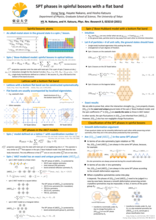 |
Symmetry-protected Topological Phases in Spinful Bosons with a Flat BandWe theoretically demonstrate that interacting symmetry-protected topological (SPT) phases can be realized with ultracold spinful bosonic atoms loaded on the lattices which have a flat band at the bottom of the band structure. Ground states of such systems are not conventional Mott insulators in the sense that the ground states possess not only spin fluctuations but also non-negligible charge fluctuations. The SPT phases in such systems are determined by both spin and charge fluctuations at zero temperature. We find that the many-body ground states of such systems can be exactly obtained in some special cases, and these exact ground states turn out to serve as representative states of the SPT phases. As a concrete example, we demonstrate that spin-1 bosons on a sawtooth chain can be in an SPT phase protected by Z2×Z2 spin rotation symmetry or time-reversal symmetry, and this SPT phase is a result of spin fluctuations. We also show that spin-3 bosons on a kagome lattice can be in an SPT phase protected by D2 point group symmetry, but this SPT phase is, however, a result of charge fluctuations. [1] Hong Yang, Hayate Nakano, and Hosho Katsura, Phys. Rev. Research 3, 023210 (2021)
|
 Jeremy Young jeremy.young@jila.colorado.edu JILA, University of Colorado, and NIST 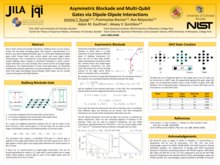 |
Asymmetric blockade and multi-qubit gates via dipole-dipole interactionsDue to their strong and tunable interactions, Rydberg atoms can be used to realize fast two-qubit entangling gates. We propose a generalization of a generic two-qubit Rydberg-blockade gate to multi-qubit Rydberg-blockade gates which involve both many control qubits and many target qubits simultaneously. This is achieved by using strong microwave fields to dress nearby Rydberg states, leading to asymmetric blockade in which control-target interactions are much stronger than control-control and target-target interactions. The implementation of these multi-qubit gates can drastically simplify both quantum algorithms and state preparation. To illustrate this, we show that large Greenberger-Horne-Zeilinger (GHZ) states can be created using very few gates with high fidelities. |
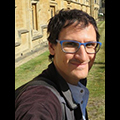 Yaakov Yudkin yaakov.yudkin@gmail.com Bar-Ilan University 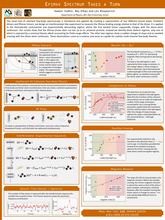 |
Efimov Energy Level Rebounding from the Atom-Dimer ContinuumEfimov physics with its ladder of weakly bound three-atomic molecules (trimers) is a fundamental building block of universal few-body physics. The van der Waals interaction, which governs the collisions between ultracold atoms, was found to provide a new twist to the concept of universality in the regime where no weakly bound two-body bound states (dimers) exist. The opposite regime (where the dimer exists) does not follow the same rule and behaves increasingly non-universal, especially for the two lowest Efimov energy levels. To probe this challenging regime we create a coherent superposition of dimers and trimers and extract the energy difference from a measurement of their time evolution. As a result we reveal yet another twist, this time within the non-universality of the first excited Efimov energy level. Instead of merging with the atom-dimer continuum it rebounds from it and becomes a deeper bound state again. Instead of a tangential approach between the two levels we observe a rather narrow resonance, providing a new challenge and a possible guide for realistic few-body theories. |

